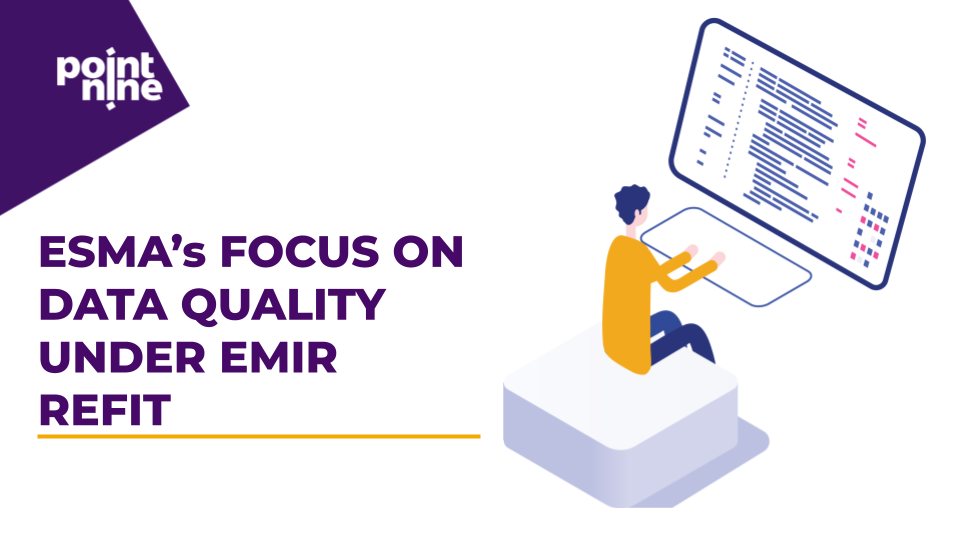A Point Nine Guide to Collateral Reporting for the purposes of limiting credit exposure between counterparties; ESMA requires counterparties to deposit margin as a means of collateral. This will ensure that, in the event of a counterparty default, margin protects the surviving party by absorbing losses using the collateral provided by the default entity. Three types of margin are identified.
Initial Margin
With regard to regulatory technical standards for risk-mitigation techniques for OTC derivative contracts not cleared by a central counterparty, initial margin is the collateral collected by a counterparty to cover its current and potential future exposure in the interval between the last collection of margin and the liquidation of positions or hedging of market risk following a default of the other counterparty.
- Where collateral is collected as initial margin, the following limits shall apply for each collecting counterparty:
The sum of the values of the initial margin collected from the asset classes referred to in points (b), (f), (g), and (l) to (r) (Asset classes – Article 4) on the asset classes list below, issued by a single issuer or by entities which belong to the same group does not exceed the greater of the following values:- 15 % of the collateral collected from the posting counterparty.
- EUR 10 million or the equivalent in another currency.
- The sum of the values of the initial margin collected from the asset classes referred to in points (o), (p) and (q) (Asset classes – Article 4) on the asset classes list below, where the asset classes referred to in points (p) and (q) (Asset classes – Article 4) of that list are issued by institutions, does not exceed the greater of the following values:
- 40 % of the collateral collected from the posting counterparty.
- EUR 10 million or the equivalent in another currency.
- Where collateral is collected as initial margin in excess of EUR 1 billion and each of the counterparties are G-SIIs (global systemically important institutions) or O-SIIs (other systemically important institutions) or counterparties which are not pension scheme arrangements and for which the sum of the values of the collateral to be collected exceeds EUR 1 billion, the following limits to the amount of initial margin in excess of EUR 1 billion collected from a counterparty shall apply:
- The sum of the values of the initial margin collected from the asset classes referred to in points (c) to (l) (Asset classes – Article 4) issued by a single issuer or by issuers domiciled in the same country shall not exceed 50 % of the initial margin collected from that counterparty;
- Where initial margin is collected in cash, the 50 % concentration limit shall also take into account the risk exposures arising from the third-party holder or custodian holding that cash.
- Counterparties shall calculate initial margin no later than the business day following one of these events:
- where a new non-centrally cleared OTC derivative contract is executed or added to the netting set;
- where an existing non-centrally cleared OTC derivative contract expires or is removed from the netting set;
- where an existing non-centrally cleared OTC derivative contract triggers a payment or a delivery other than the posting and collecting of margins;
- where the initial margin is calculated in accordance with the standardised approach and an existing contract is reclassified in terms of the asset category as a result of reduced time to maturity;
- where no calculation has been performed in the preceding 10 business days.
Calculation of Initial Margin
Counterparties shall calculate the amount of initial margin to be collected using either the standardised approach set out in Annex IV or the initial margin models or both. The collection of initial margin shall be performed without offsetting the initial margin amounts between the two counterparties.
- Initial Margin Model: Initial margin models shall be developed in a way that captures all the significant risks arising from entering into the non-centrally cleared OTC derivative contracts included in the netting set, including the nature, scale, and complexity of those risks and shall meet the following requirements:
- Currency risk factors
- Interest rate risk factors
- The yield curve
- The risk of movements between different yield curves
- Separate risk factors at least for each equity, equity index, commodity or commodity index
- The risk arising from less liquid positions and positions with limited price transparency
- Non-linear dependencies
- Determines which events trigger a model change
- The risk of movements between similar, but not identical, underlying risk factors
- Incorporates methodologies used for back-testing which include statistical tests of the model’s performance
- Standardised Method: The notional amounts or underlying values, as applicable, of the OTC derivative contracts in a netting set shall be multiplied by the percentages according to table 1 below. The gross initial margin of a netting set shall be calculated as the sum of the products for all OTC derivative contracts in the netting set.
- The following treatment shall be applied to contracts which fall within more than one category:
- where a relevant risk factor for an OTC derivative contract can be clearly identified, contracts shall be assigned to the category corresponding to that risk factor
- where the condition referred to in point (a) is not met, contracts shall be assigned to the category with the highest add-on factor among the relevant categories
- the initial margin requirements for a netting set shall be calculated in accordance with the below formula where
- Net initial margin refers to the reduced figure for initial margin requirements for all OTC derivative contracts with a given counterparty included in a netting set;
- NGR refers to the net-to-gross ratio calculated as the quotient of the net replacement cost of a netting set with a given counterparty in the numerator, and the gross replacement cost of that netting set in the denominator.
- The following treatment shall be applied to contracts which fall within more than one category:
Net initial margin = 0,4 * Gross initial margin + 0,6 * NGR * Gross initial margin.
Table 1
| Category | Add-on Factor |
| Credit: 0-2 year residual maturity | 2% |
| Credit: 2-5 year residual maturity | 5% |
| Credit: 5+ year residual maturity | 10% |
| Commodity | 15% |
| Equity | 15% |
| Foreign Exchange | 6% |
| Interest rate and inflation: 0-2 year residual maturity | 1% |
| Interest rate and inflation: 2-5 year residual maturity | 2% |
| Interest rate and inflation: 5+ year residual maturity | 4% |
| Other | 15% |
Variation Margin
With regard to regulatory technical standards for risk-mitigation techniques for OTC derivative contracts not cleared by a central counterparty, variation margin is the collateral collected by a counterparty to reflect the results of the daily marking-to-market or marking-to-model of outstanding contracts, and can therefore change over time. It protects the transacting parties from the current exposure that has already been incurred by one of the parties from changes in the mark-to-market value of the contract after the transaction has been executed. Counterparties must calculate variation margin at least on a daily basis.
Calculation of Variation Margin
The amount of variation margin to be collected by a counterparty under EMIR is the aggregation of the values calculated as a result of the marking-to-market process on a daily basis. This amount is calculated using the following formula:
Value of all outstanding contracts in Netting set – value of VM previously collected – value of each contract in the netting set at the point of entry into the contract + the value of all VM previously posted.
‘Netting set’ is defined as “a set of non-centrally cleared over-the-counter (‘OTC’) derivative contracts between two counterparties that is subject to a legally enforceable bilateral netting agreement”.
Excess Margin
Is the amount of assets a clearing member requires from its client in respect of a client transaction that is over and above the amount of assets the CCP requires from a clearing member in respect of the related CCP transaction.
The manner in which the excess margin is dealt with by the clearing broker depends on whether the clearing client has an individual client account or an omnibus client account. In the case of an individual client account the excess margin collected by the clearing member from the clearing client in respect of the related client transactions, is required to be passed onto a CCP. Such protection does not function when it comes to an omnibus client account, where the clearing member is not required to pass any excess margin onto the CCP.
Collateralization
- Where no collateral agreement exists between the counterparties or where the collateral agreement between the counterparties stipulates that the reporting counterparty does not post neither initial margin nor variation margin with respect to the derivative contract, the type of collateralisation of the derivative contract shall be identified as uncollateralized (U).
- Where the collateral agreement between the counterparties stipulates that the reporting counterparty only regularly posts variation margins with respect to the derivative contract, the type of collateralisation of the derivative contract shall be identified as partially collateralized (PC) .
- Where the collateral agreement between the counterparties stipulates that the reporting counterparty posts the initial margin and regularly posts variation margins and that the other counterparty either posts only variation margins or does not post any margins with respect to the derivative contract, the type of collateralisation of the derivative contract shall be identified as one-way collateralised (OC)
- Where the collateral agreement between the counterparties stipulates that both counterparties post initial margin and regularly post variation margins with respect to the derivative contract, the type of collateralisation of the derivative contract shall be identified as fully collateralized (FC).





